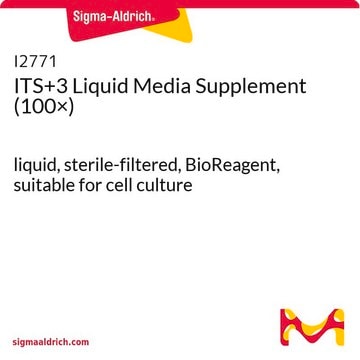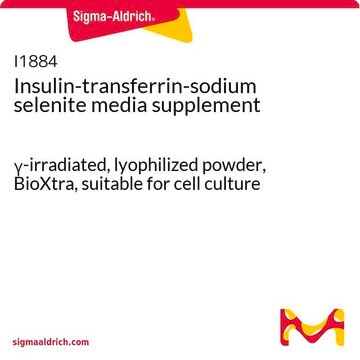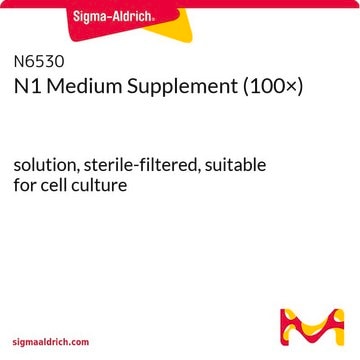I3146
ITS Liquid Media Supplement (100×)
liquid, sterile-filtered, BioReagent, suitable for cell culture
Synonym(s):
Human ITS Liquid Media, Insulin-transferrin-sodium selenite
About This Item
Recommended Products
sterility
sterile-filtered
product line
BioReagent
form
liquid
technique(s)
cell culture | mammalian: suitable
single cell analysis: suitable
impurities
endotoxin, tested
shipped in
ambient
storage temp.
2-8°C
Application
- α mouse liver 12 (AML-12) cells
- rat fetal testis explants
- human dental pulp stem cells (DPSC)
Biochem/physiol Actions
- Insulin: a polypeptide hormone that promotes the uptake of glucose and amino acids and may owe an observed mitogenic effect to this property.
- Transferrin: an iron-transport protein.
- Selenium: an essential trace element normally provided by serum.
Components
Other Notes
Preparation Note
Storage Class
12 - Non Combustible Liquids
wgk_germany
WGK 1
flash_point_f
Not applicable
flash_point_c
Not applicable
ppe
Eyeshields, Gloves, multi-purpose combination respirator cartridge (US)
Certificates of Analysis (COA)
Search for Certificates of Analysis (COA) by entering the products Lot/Batch Number. Lot and Batch Numbers can be found on a product’s label following the words ‘Lot’ or ‘Batch’.
Already Own This Product?
Find documentation for the products that you have recently purchased in the Document Library.
Customers Also Viewed
Articles
Understand the role of selenium in cell culture media formulations. The Media Expert library explains how culture media ingredients support cell growth.
Understand how transferrin affects serum-free cell culture systems, crucial for biomanufacturing heterologous proteins like monoclonal antibodies.
Our team of scientists has experience in all areas of research including Life Science, Material Science, Chemical Synthesis, Chromatography, Analytical and many others.
Contact Technical Service









